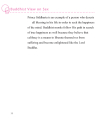Buddhist practices : ค้นหาหนังสือธรรมะ หน้า 5 / 9
หน้าหนังสือทั้งหมด

127
The Practice of Ānāpānasmṛti: Breath Meditation in Early Buddhism
describing the practice of the four smrtyṣhānas associated with the breath (ānāpānasmṛti), and resulting the attainment of the three vimoksamukhās.42
An Shigao’s translation of the Ānāpānasmṛti Sūtra
This text delves into the practice of Ānāpānasmṛti, a significant Buddhist meditation focused on breath. It highlights An Shigao’s translation of the Ānāpānasmṛti Sūtra and its influence on later monk

11
The Rise of a Moral Hero
A MORAL HERO
In our tumultuous world today in which wars, economic turmoil, family crisis, and the breakdown in human values affect everyone, a new kind of hero is needed—a “moral hero”. Like war, pe
…g meditation and good deeds. His initiatives have led to a significant number of people engaging in Buddhist practices, including ordaining as monks and participating in ethics training. Wat Phra Dhammakaya has transfo…

163
Understanding Pali and Parami in Buddhism
Pali: an ancient language used in India, now no longer an active language. The original Buddhist scriptures were written in Pali. Pali texts are used by the Theravada school of Buddhism.
Parami: a Pa
Pali is an ancient language from India that is no longer actively spoken but holds significant historical importance as the original language of Buddhist scriptures. These scriptures serve as a core e

61
The Pali Language and the Theravadin Tradition
NORMAN, K.R.
1983 “The Pali Language and the Theravadin Tradition.”
A History of Indian Literature: 1-2, edited by Jan Gonda. Wiesbaden: Otto Harrassowitz.
PEW Research Center.
2017 “World Bu
…hist tradition. It examines its historical roots, literary contributions, and the ongoing impact on Buddhist practices. Pali serves as a crucial linguistic medium in understanding ancient Buddhist texts and teachings. …

48
DMC และ Buddhist TV ลงนาม MOU อย่างเป็นทางการ
DMC
The Only One Channel
Official MOU Sign
between
Dhammakaya Media Channel
&
The Buddhist TV Chann
on Wes
29 ten
20
Buddhist TV คือ สถานีโทรทัศน์ที่มาพร้อม
สโลแกน "The Buddhist Peace of Mind to All”
Buddhist TV คือสถานีโทรทัศน์ที่มีสโลแกน 'ความสงบสุขทางใจสำหรับทุกคน' เปิดให้บริการตั้งแต่ปี 2550 ในภาษาสิงหล อังกฤษ และทมิฬ โดยมีการออกอากาศ 24 ชั่วโมง พร้อมข่าวดีว่า Buddhist TV จะมอบเวลาออกอากาศให้

50
คุณยายวัย 94 ปี เดินทางไปกราบธรรมทูตจากวัดพระธรรมกาย
DMG
Octo
คุณยายท่านหนึ่ง อายุ ๙๔ ปี หลังจากได้ดูรายการถ่ายทอดสดก็รู้สึกปลื้มปีติจนทนอยู่บ้านไม่ไหว
ต้องออกเดินทางจากบ้านตั้งแต่ตี 4 ของวันรุ่งขึ้น พาลูกหลานอีก ๔๐ ชีวิต มาถึงสถานี Buddhist
TV เพื่อจะม
เรื่องราวของคุณยายวัย 94 ปี ที่รู้สึกปลื้มปีติหลังได้ชมรายการถ่ายทอดสด จึงตัดสินใจเดินทางไปยังสถานี Buddhist TV พร้อมลูกหลานเพื่อกราบก๊วนธรรมทูตจากวัดพระธรรมกาย ถึงแม้จะมีระยะทางถึง 6 ชั่วโมง แต่ความต

188
Message from the Founder and Secretary General of WBSY
Message from Founder and Secretary General of WBSY
It was a greatly inspiring occasion for the World Buddhist Sangha Youth of Sri Lanka to organize the Third General Conference of the World Buddhist
The World Buddhist Sangha Youth of Sri Lanka organized their Third General Conference from 2nd - 5th December 2006, themed 'Tolerance and Harmony'. The event included the 2550 Buddha Jayanti award cer

9
Yuwakalanayamittra Training and Its Impact
activities such as music composing for the 1985 New Year celebration, and exercises on public speaking, advocacy and fundraising for Kathina or robe offerings thus constituted their daily routine. Som
The Yuwakalanayamittra training program has significantly influenced children's lives since its inception. In 1985, activities like music composing and public speaking prepared them for spiritual lead

20
Exploring the Cakras and Early Buddhism
the cakras are located, a location that suggests comparisons with Tantra.
While the primary focus of this journal is dhammakāya, Luang Phaw Dhammajayo has instructed the Director of DIRI, Phrakrupladn
This journal focuses on the study of cakras and early Buddhism, emphasizing neutrality across Buddhist schools. Under the direction of Luang Phaw Dhammajayo, the Director of DIRI, Phrakrupladnayokwara

101
Understanding the Pāli Verses and Buddhist Doctrine
The Text
The first nine leaves are inscribed with Pāli verses and a commentary in Tai Yuan.4 The final leaf of the manuscript is an addendum, inscribed with a stanza of the Dvatiṃsa-mahāpuruśa-lakkhaṇ
The manuscript presents Pāli verses and commentary in Tai Yuan, summarizing Buddhist doctrines about the Buddha's physical body and wisdom. It includes thirty stanzas highlighting qualities like divin

251
หลักฐานธรรมในคัมภีร์พระธรรม
หลักฐานธรรมในคัมภีร์พระธรรมนั้น 1 ฉบับประชาชน
Harrison, Paul M. 1990. The Samādhi of direct encounter with the Buddhas of the present: an annotated English translation of the Tibetan version of the P
เนื้อหานี้นำเสนอการสำรวจหลักฐานธรรมในคัมภีร์พระธรรมโดยการอ้างอิงงานศึกษาที่สำคัญเกี่ยวกับ Dhamma-kāya และความสัมพันธ์ระหว่างมันกับการบรรลุ enlightenment งานที่สำคัญเช่น เพื่อบันทึกการพัฒนาและการประยุก

83
Paleographical Analysis and Buddhist Manuscripts
Sander, Lore. 2000. “Appendix: A brief paleographical analysis of the Braāhmī manuscripts in volume I.” In J. Braarvig, eds., Buddhist manuscripts vol 1, pp. 285-300. Oslo: Hermes Pub. Original editio
This section presents a brief paleographical analysis of the Brahmi manuscripts in Buddhist texts as compiled by various scholars. Notable contributions include analyses by Sander (2000) on manuscript

50
Computerization of the Buddhist Pali Canon
The text in the image reads:
"The Computerization of the Buddhist Pali Canon
With the recognition that many world scholars have been impeded from fully studying the Buddhist scriptures by inconvenie
The Computerization of the Buddhist Pali Canon began in 1984 by the Dhammakaya Foundation to improve access for scholars worldwide. Utilizing the Romanized Pali Canon Text, the project produced a data

72
Understanding Vinaya: The Code of Conduct in Buddhism
'Vinaya' means 'code of conduct', 'discipline' and 'regulations'on the behaviour of individuals. As a collection, it is the name of the first portion of the Buddhist Canon [Vinaya-piṭaka] which deals
Vinaya refers to the code of conduct governing the behavior of individuals within the Buddhist community, particularly monks and nuns. It encompasses the Vinaya-piṭaka, the first portion of the Buddhi

125
Understanding Key Buddhist Concepts
"Fools" (palay): spiritually defective people. A fool is someone wicked, weak, or feeble in a moral sense. His discretion is faulty, not knowing right from wrong, good from bad. A fool is one who give
This content delves into various Buddhist concepts such as 'fools'—spiritually defective individuals whose actions reflect moral weakness. It explains that heaven in Buddhism comprises six levels prov

3
Analyzing the Dhammacakkappavattana Sutta: A Text-Critical Approach
The Document Research Methods
Case Study: The Dhammakakkappavattana Sutta
Pramaha Pongsak THANIO
Abstract
Dhammacakkappavattana Sutta (Sanskrit: Dharmacakaravartana
Sutra) is regarded as one of the
The Dhammacakkappavattana Sutta, a key Buddhist text, shows multiple versions arising after the Buddha’s death, raising authenticity questions. This research employs text-critical methods to establish

30
Vinayapitaka Editions and References
Vinayapitaka vol.IV. 2001. edited by Hermann Oldenberg. Oxford:
PTS. (first printed. 1882)
Vinayapitaka vol.V. 2006. edited by Hermann Oldenberg. Oxford:
PTS. (first printed. 1883)
อ้างอิงอื่น ๆ
PT
Vinayapitaka editions include volumes IV and V, edited by Hermann Oldenberg, published by the Pali Text Society with first prints in 1882 and 1883 respectively. Other important references include Nori

6
Exploring Early Buddhist Schools: Pāli and Chinese Connections
considered to have already appeared in the early Buddhist schools (Hinayāna) period at the latest and to have been widely recognized by at least two schools in company of them.
Throughout a study of t
This study examines the connections between Pāli and Chinese stanzas through early Buddhist schools, specifically focusing on: (1) Two Pāli stanzas aiding the understanding of Chinese transliterated t

36
Buddhist View on Sex
Buddhist View on Sex
Prince Siddharta is an example of a person who deserts
all blessing in his life in order to seek the happiness
of the mind. Buddhist monks follow His path in search
of true happin
Prince Siddharta represents a figure who renounces worldly pleasures to pursue mental happiness. Buddhist monks emulate his journey, viewing celibacy as a key to liberation from suffering and a path t

6
Creating Harmony and Understanding in Family and Society
Part Three ~ Harmony in the Family 157
Chapter 15 Creating Harmony in the Family 159
Chapter 16 What Should Parents Do When Their Children Do Not Get Along? 165
Chapter 17 Remedying the Situation When
…life's value and the legacy left for future generations, encouraging self-discipline and respect in Buddhist practices. For more information, visit dmc.tv.
